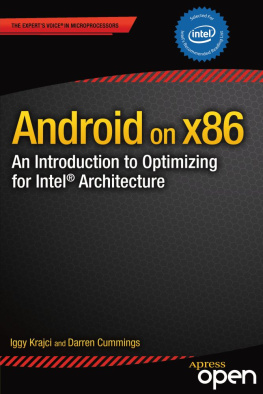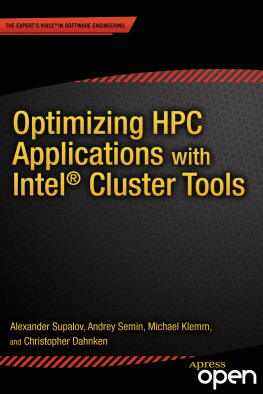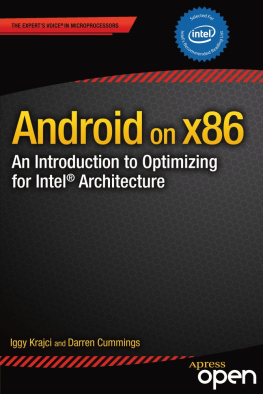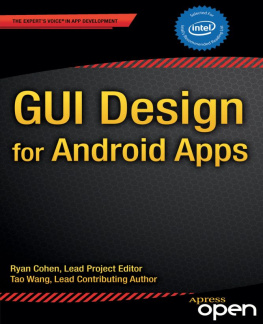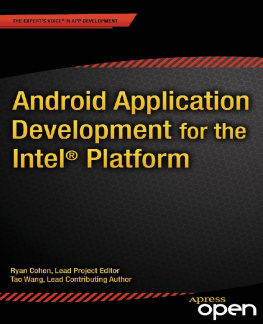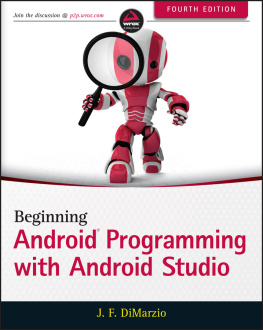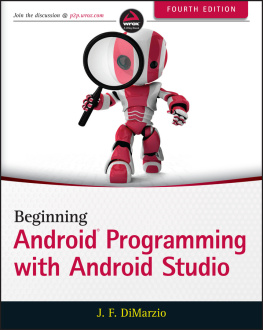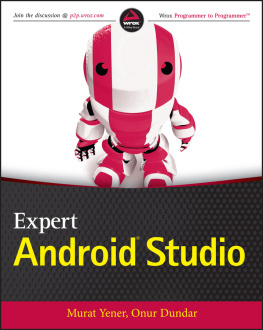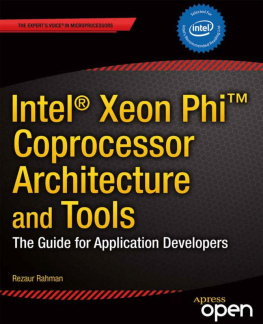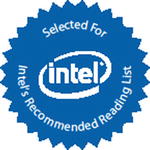Iggy Krajci - Android on x86: An Introduction to Optimizing for Intel® Architecture
Here you can read online Iggy Krajci - Android on x86: An Introduction to Optimizing for Intel® Architecture full text of the book (entire story) in english for free. Download pdf and epub, get meaning, cover and reviews about this ebook. year: 2013, publisher: Apress, genre: Computer. Description of the work, (preface) as well as reviews are available. Best literature library LitArk.com created for fans of good reading and offers a wide selection of genres:
Romance novel
Science fiction
Adventure
Detective
Science
History
Home and family
Prose
Art
Politics
Computer
Non-fiction
Religion
Business
Children
Humor
Choose a favorite category and find really read worthwhile books. Enjoy immersion in the world of imagination, feel the emotions of the characters or learn something new for yourself, make an fascinating discovery.
- Book:Android on x86: An Introduction to Optimizing for Intel® Architecture
- Author:
- Publisher:Apress
- Genre:
- Year:2013
- Rating:5 / 5
- Favourites:Add to favourites
- Your mark:
Android on x86: An Introduction to Optimizing for Intel® Architecture: summary, description and annotation
We offer to read an annotation, description, summary or preface (depends on what the author of the book "Android on x86: An Introduction to Optimizing for Intel® Architecture" wrote himself). If you haven't found the necessary information about the book — write in the comments, we will try to find it.
Android on x86: an Introduction to Optimizing for Intel Architecture serves two main purposes. First, it makes the case for adapting your applications onto Intels x86 architecture, including discussions of the business potential, the changing landscape of the Android marketplace, and the unique challenges and opportunities that arise from x86 devices. The fundamental idea is that extending your applications to support x86 or creating new ones is not difficult, but it is imperative to know all of the technicalities. This book is dedicated to providing you with an awareness of these nuances and an understanding of how to tackle them.
Second, and most importantly, this book provides a one-stop detailed resource for best practices and procedures associated with the installation issues, hardware optimization issues, software requirements, programming tasks, and performance optimizations that emerge when developers consider the x86 Android devices. Optimization discussions dive into native code, hardware acceleration, and advanced profiling of multimedia applications. The authors have collected this information so that you can use the book as a guide for the specific requirements of each application project.
This book is not dedicated solely to code; instead it is filled with the information you need in order to take advantage of x86 architecture. It will guide you through installing the Android SDK for Intel Architecture, help you understand the differences and similarities between processor architectures available in Android devices, teach you to create and port applications, debug existing x86 applications, offer solutions for NDK and C++ optimizations, and introduce the Intel Hardware Accelerated Execution Manager. This book provides the most useful information to help you get the job done quickly while utilizing best practices.
What youll learn- The development-relevant differences between Android on ARM and Android on Intel x86
- How to set up the SDK for an emulated Intel Android device
- How to build the Android OS for the Intel Mobile Processor
- How to create new x86 based Android applications, set up testing and performance tuning, and port existing Android applications to work with the x86 processor
- How to debug problems they encounter when working on the x86 Android test platform
- Intricacies of the Intel Hardware Accelerated Execution Manager. The reader will also gain significant insight into the OpenGL Android support.
- Android developers
- Hardware designers who need to understand how Android will work on their processors
- CIOs and CEOs of technology-based companies
- IT staff who may encounter or need to understand the issues
- New startup founders and entrepreneurs
- Computer science students
Chapter 2: Mobile Device Applications Uses and Trends
Chapter 3: Why x86 on Android?
Chapter 4: Android Development Business Overview andConsiderations
Chapter 5: Android Devices with Intel Processors
Chapter 6: Installing the Android SDK for IntelApplication Development
Chapter 7: The Intel Mobile Processor
Chapter 8: Creating and Porting NDK-based AndroidApplications
Chapter 9: Debugging Android
Chapter 10: Performance Optimization for AndroidApplications on x86
Chapter 11: x86 NDK and C++ Optimizations
Chapter 12: Intel Hardware Accelerated Execution Manager
Iggy Krajci: author's other books
Who wrote Android on x86: An Introduction to Optimizing for Intel® Architecture? Find out the surname, the name of the author of the book and a list of all author's works by series.

